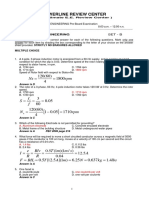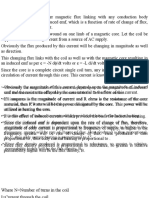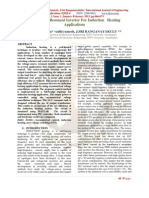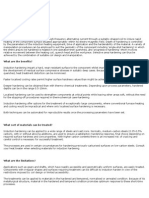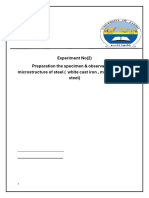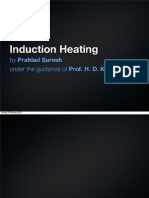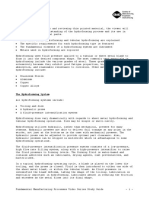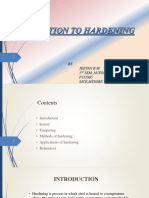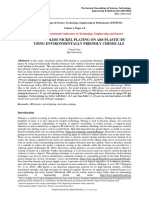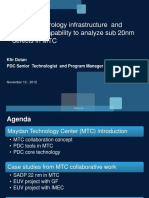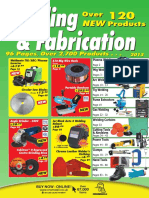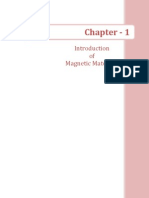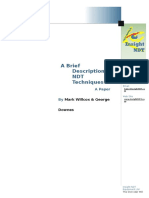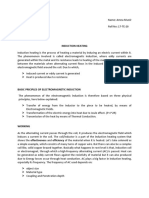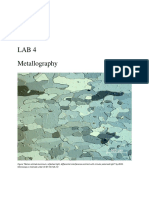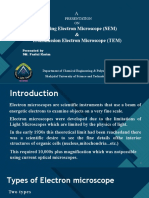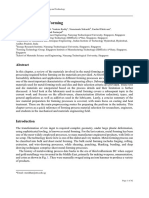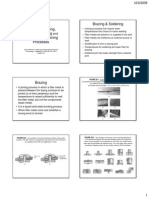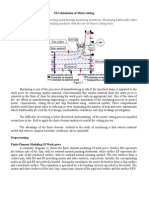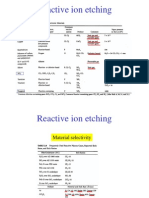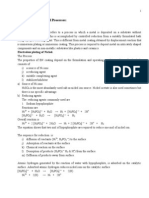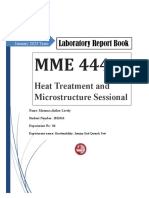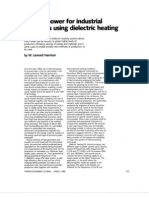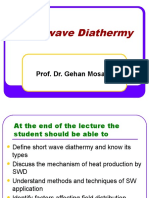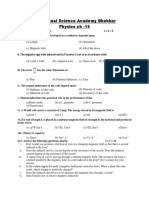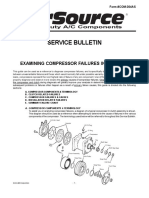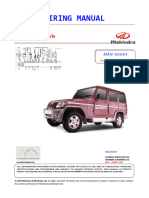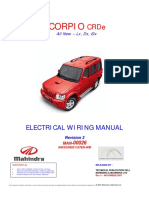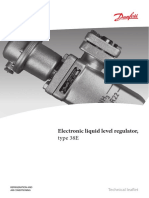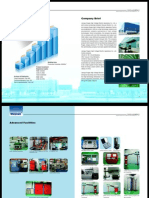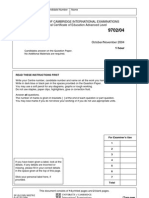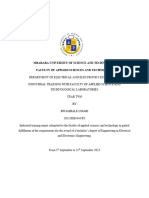High-Frequency Induction Heating
High-Frequency Induction Heating
Uploaded by
agameronCopyright:
Available Formats
High-Frequency Induction Heating
High-Frequency Induction Heating
Uploaded by
agameronOriginal Title
Copyright
Available Formats
Share this document
Did you find this document useful?
Is this content inappropriate?
Copyright:
Available Formats
High-Frequency Induction Heating
High-Frequency Induction Heating
Uploaded by
agameronCopyright:
Available Formats
HIGH-FREQUENCY INDUCTION HEATING
High-frequency Induction Heating
BY
FRANK W. CURTYS
Chief Engineer, Van Norman Company
Second Edition
McGRAW-HILL BOOK COMPANY, INC. NEW YORK TORONTO 1950 LONDON
PREFACE TO THE SECOND EDITION
Induction heating has undergone many improvements during the past few years, largely in connection with application techniques. While principles have remained the same, a better knowledge of their use prevails, and today users of high-frequency generators have a broader selection of coils, fixtures and process data to draw form for the solution of heating problems. In this edition a more comprehensive analysis of coil design has been included. A work coil is the basis around which induction heating functions. Therefore, by having a wider variety of designs from which choose, the more efficient can a setup be made. Many new forms of coils are described, together with basic principles with which the user of high-frequency equipment should be familiar. The discussion of fixture designs likewise has been expanded, because, along with coils, they form the most important considerations form successfully processing parts by means of induction heat. Localized hardening and the joining of metal assemblies are the principle uses for induction heating, and the chapters dealing with these two applications include a more comprehensive analysis of production requirements. Types of steels best suited to induction hardening, various means of quenching, soft solders, brazing alloys and fluxes all are treated in greater detail. Users of high-frequency heating equipment invariably seek technical information relating to application problems and it is in response to this need that the second edition has been enlarged.
Frank W. Curtis
PREFACE TO THE FIRST EDITION
The purpose of this book is to offer the user of high-frequency induction-heating equipment basic technical application details that will serve as a ready reference in connection with the heating of metal parts, such as may be required for hardening, heat-treating, brazing, soldering, annealing, stressrelieving, forging, upsetting, or melting. Though the generation of highfrequency current is an electrical function, putting this current to practical use becomes almost entirely mechanical. It is with this thought in mind that the user of induction-heating equipment is more concerned. Therefore, other than brief references to electrical data characteristic to this type of heating, the text is confined to application technique. High-frequency heating has already demonstrated remarkable versatility in many industries and without doubt will exert a marked influence on future product design and manufacturing process-planning. Heating methods have always undergone a transition of one kind or another, and it is logical to assume that induction-heating principles will open an important field of possibilities in economies and production gains. The text includes a broad coverage of heating coils and fixtures as used in hardening and joining operations, since these constitute the main requirements of a successful application. References area made to product design because technically there are advantages in considering the fundamental needs of induction heating when constructional details of a component are originated. In view of the association so often made between induction heating and dielectric heating, a brief chapter has been included on the latter, mainly for the purpose of showing the differences between these two methods of heat transfer. This textbook would not have been possible without the generous assistance of manufacturers and users of high-frequency equipment who have contributed illustrations showing induction-heating illustrations in use. The author takes this opportunity to thank the following manufactures for their valuable assistance: Ajac Electrothermic Corporation; Ecco High Frequency Corporation, Federal Telephone & Radio Corporation; Girdler Corporation; Induction Heating Corporation; Tocco Division; The Ohio Crankshaft Company; and Westinghouse Electric & Manufacturing Company. He thanks also Glen C. Riegel, of the Caterpillar Tractor Company, and Richard F. Harvey, of the Brown & Sharpe Manufacturing Company. Deep appreciation is also extended to the Induction Heating Corporation for its help in making available many case histories an laboratory analyses of inductionheating problems. Frank W. Curtis
CONTENTS
Preface to the second edition Preface to the first edition I. Principles of Induction Heating Diagrams of current paths Basic principles involved Relation of frequency Heating coils used Heating formula Effect of surface heating on metals Induction-heating Equipment Motor-generator sets Vacuum-tube oscillators Selection of equipment Diagram of circuits Miscellaneous units Spark-gap converters Design of Induction-heating Coils Single-turn and multi-turn coils Constructional design details Coil proportions Series-type coils Parallel inductors Miscellaneous coils Mounting of coils Built-up coil design Brazing, Soldering, and Joining Brazing with silver alloys Types of brazed joints Fixtures for production setups Continuous soldering operations Multiple setups Brazing carbide tools Miscellaneous seups
II.
III.
IV.
You might also like
- RTD Temperture Measurement 917ADocument15 pagesRTD Temperture Measurement 917AJohn Rey AranoNo ratings yet
- Chapter 8 Ion Implantation - IDocument40 pagesChapter 8 Ion Implantation - IKowshick GuruNo ratings yet
- Preboard Sept 2013 Set B SolutionDocument20 pagesPreboard Sept 2013 Set B Solutionmark ian100% (4)
- Induction HeatingDocument17 pagesInduction HeatingRam Kumar Gogada100% (1)
- Universiti Teknologi Mara Lab 1Document11 pagesUniversiti Teknologi Mara Lab 1Ilman Faiq67% (9)
- Induction Heat Treatment TechnologyDocument6 pagesInduction Heat Treatment TechnologyEsmaeil NaNo ratings yet
- Applications of Eutectic AuDocument2 pagesApplications of Eutectic AuJheza Banayo100% (1)
- Magnetic Properties of MaterialsDocument23 pagesMagnetic Properties of MaterialsjsusromorNo ratings yet
- Induction Heating PaperDocument8 pagesInduction Heating PaperSyed Salman AliNo ratings yet
- Design and Construction of An Inverter Type Arc Welding MachineDocument45 pagesDesign and Construction of An Inverter Type Arc Welding MachineDaniel100% (1)
- Eddycurrent TestingDocument4 pagesEddycurrent TestingnvemanNo ratings yet
- 03 - Iron - Iron CarbideDocument35 pages03 - Iron - Iron CarbidebotobotoakbarNo ratings yet
- Material PropertiesDocument10 pagesMaterial PropertiesRehan SheikhNo ratings yet
- Microstructure Simulation of Copper Tube and Its Application in Three Roll Planetary RollingDocument9 pagesMicrostructure Simulation of Copper Tube and Its Application in Three Roll Planetary RollingandrreaskinzNo ratings yet
- Fundamentals of Metal FormingDocument9 pagesFundamentals of Metal FormingGeorge CamachoNo ratings yet
- Induction HardeningDocument2 pagesInduction HardeningJassi SandhuNo ratings yet
- Surface Science of Tin Oxide PDFDocument108 pagesSurface Science of Tin Oxide PDFJorge Alexis RamosNo ratings yet
- Triton-Ocean Bottom Seismometer-001Document2 pagesTriton-Ocean Bottom Seismometer-001Furio RuggieroNo ratings yet
- Induction Heating Process Design Using Comsol Multiphysics Software Version 42aDocument4 pagesInduction Heating Process Design Using Comsol Multiphysics Software Version 42areaktorenergiNo ratings yet
- Metallurgy2 YasserDocument10 pagesMetallurgy2 Yasserroneali098No ratings yet
- Friction WeldingDocument20 pagesFriction WeldingNallappan Rajj ANo ratings yet
- Automatic Frequency Control of An Induction FurnaceDocument4 pagesAutomatic Frequency Control of An Induction FurnaceNarendra BholeNo ratings yet
- Induction HeatingDocument57 pagesInduction HeatingPrahlad Suresh100% (3)
- Friction Stir Welding ReportDocument16 pagesFriction Stir Welding ReportjishnuNo ratings yet
- Technology of Machine ToolsDocument60 pagesTechnology of Machine ToolsMayank SharmaNo ratings yet
- Hydroforming PDFDocument5 pagesHydroforming PDFdramiltNo ratings yet
- Materials Lab - Material CharacterisationDocument12 pagesMaterials Lab - Material Characterisationjamieblackburn201No ratings yet
- Cathodic Arc DepositionDocument3 pagesCathodic Arc DepositionBrandon DavisNo ratings yet
- Development of Hot Cells and Their Embedded PartsDocument3 pagesDevelopment of Hot Cells and Their Embedded PartsK. JayarajanNo ratings yet
- BY Jeevan B M 1 Sem, Automotive Electronics P151905 Sjce, MysoreDocument17 pagesBY Jeevan B M 1 Sem, Automotive Electronics P151905 Sjce, Mysoreجاسم جبرNo ratings yet
- Experimental Measurement of Boiling Point ElevationDocument33 pagesExperimental Measurement of Boiling Point Elevationsuleman205100% (3)
- Data Collector QSG ED10Document97 pagesData Collector QSG ED10LiudmilaNo ratings yet
- Electroless Nickel Plating On Abs Plastic by Using Environmentally Friendly Chemicals (#350219) - 379925Document8 pagesElectroless Nickel Plating On Abs Plastic by Using Environmentally Friendly Chemicals (#350219) - 379925miguelin9169No ratings yet
- Brazing: Brazing Is A Joining Process Whereby A NonDocument23 pagesBrazing: Brazing Is A Joining Process Whereby A Nonshayan sohailNo ratings yet
- Advanced Metrology Infrastructure and Inspection Capability To Analyze Sub 20nm Defects-Kfir - Dotan - AMATDocument27 pagesAdvanced Metrology Infrastructure and Inspection Capability To Analyze Sub 20nm Defects-Kfir - Dotan - AMATHamid HamidNo ratings yet
- Welding & Fabrication PDFDocument96 pagesWelding & Fabrication PDFVicente Banda Zuñiga100% (1)
- 06 Chapter 1Document14 pages06 Chapter 1Sunil SharmaNo ratings yet
- A Brief Description of NDTDocument31 pagesA Brief Description of NDTVictor SandovalNo ratings yet
- Nanotechnology in SensorsDocument8 pagesNanotechnology in SensorsAisha RobinsonNo ratings yet
- Design and Analysis of Pressure Die Casting For Door HandleDocument6 pagesDesign and Analysis of Pressure Die Casting For Door HandleEditor IJTSRDNo ratings yet
- Induction HeatingDocument3 pagesInduction HeatingAmna MunirNo ratings yet
- Lab 4 Metallography PDFDocument8 pagesLab 4 Metallography PDFjohn hayNo ratings yet
- General Principles and Processes of Isolation of ElementsDocument17 pagesGeneral Principles and Processes of Isolation of ElementsAnonymous 8VJhV1eI2y100% (1)
- Click To Edit Master Title Style: Presentation ONDocument19 pagesClick To Edit Master Title Style: Presentation ONFazlul Karim AkashNo ratings yet
- Ac Contro Llers For High Frequency Induction HeatingDocument5 pagesAc Contro Llers For High Frequency Induction HeatingAmarsingh ChoudharyNo ratings yet
- (WTC) Repair Welding in Power PlantsDocument23 pages(WTC) Repair Welding in Power PlantsSarah FrazierNo ratings yet
- Materials in Metal FormingDocument42 pagesMaterials in Metal Formingasif100% (1)
- Ch32 Brazing, Soldering, Adhesive Bonding, Mechanical Fastening HO 2Document9 pagesCh32 Brazing, Soldering, Adhesive Bonding, Mechanical Fastening HO 2Yasir MumtazNo ratings yet
- FEA Simulation of Metal CuttingDocument6 pagesFEA Simulation of Metal CuttingAnonymous p8bHAAxNo ratings yet
- Workshop Practice: Course Code: Btmp101-18Document12 pagesWorkshop Practice: Course Code: Btmp101-18Dhiraj DhimanNo ratings yet
- Centrifugal CastingDocument21 pagesCentrifugal CastingVishal VsNo ratings yet
- Etching and Lithography in MicrofabricationDocument8 pagesEtching and Lithography in MicrofabricationWhizzWrNo ratings yet
- Experiment No.4 To Study The Variation of Photoelectric Effect With Intensity of LightDocument8 pagesExperiment No.4 To Study The Variation of Photoelectric Effect With Intensity of LightMuhammad Zubair SharifNo ratings yet
- Unit 5 Electrochemical Processes:: I Electroless PlatingDocument16 pagesUnit 5 Electrochemical Processes:: I Electroless PlatingDhivya NNo ratings yet
- Electromagnetics in CFXDocument53 pagesElectromagnetics in CFXVignesh WaranNo ratings yet
- Magnetic Nano Composites - TermpaperDocument27 pagesMagnetic Nano Composites - TermpaperIrshadNo ratings yet
- Exp 4Document11 pagesExp 4masuma lovelyNo ratings yet
- Mechanisms of Plastic Deformation in MetalsDocument12 pagesMechanisms of Plastic Deformation in MetalsayushdbcNo ratings yet
- Mil STD 1580B - CHG 2 PDFDocument134 pagesMil STD 1580B - CHG 2 PDFrenatobellarosaNo ratings yet
- Electric Power For Industrial Processes Using Dielectric HeatingDocument9 pagesElectric Power For Industrial Processes Using Dielectric Heatingharit_ecNo ratings yet
- Innovation in Electric Arc Furnaces: Scientific Basis for SelectionFrom EverandInnovation in Electric Arc Furnaces: Scientific Basis for SelectionNo ratings yet
- Shortwave Diathermy: Prof. Dr. Gehan MosaadDocument29 pagesShortwave Diathermy: Prof. Dr. Gehan MosaaddvenumohanNo ratings yet
- 2Document83 pages2Kalyan Reddy AnuguNo ratings yet
- Physics File (Vansh Raje) .PDF - 20240109 - 231456 - 0000Document18 pagesPhysics File (Vansh Raje) .PDF - 20240109 - 231456 - 0000vanshraje30No ratings yet
- Fundamentals of HarmonicsDocument127 pagesFundamentals of Harmonicsraghav4life8724No ratings yet
- Ch15 Physics TestDocument2 pagesCh15 Physics TestMuhammad AwaisNo ratings yet
- Service Bulletin: Examining Compressor Failures in The FieldDocument12 pagesService Bulletin: Examining Compressor Failures in The Fieldnkrish21856No ratings yet
- MAN-00094-Bolero VLX - Wiring ManualDocument41 pagesMAN-00094-Bolero VLX - Wiring Manualjag18718No ratings yet
- Techniques and Standarts For Measuring Ferrite in Austenitic Stainless Steel WeldsDocument6 pagesTechniques and Standarts For Measuring Ferrite in Austenitic Stainless Steel WeldslkarolinoNo ratings yet
- IES-OBJ-Electrical Engineering-2005 Paper-II PDFDocument16 pagesIES-OBJ-Electrical Engineering-2005 Paper-II PDFAdityaVardhanNo ratings yet
- Scorpio Crde Wiring Manual Rev3 Reduced PDFDocument51 pagesScorpio Crde Wiring Manual Rev3 Reduced PDFhelorca100% (1)
- KPK Part 2 Smart Syllabus Class 12Document60 pagesKPK Part 2 Smart Syllabus Class 12Hassan Mohy Ud DinNo ratings yet
- RF-AMP-250-3 Debug Instructor V100Document5 pagesRF-AMP-250-3 Debug Instructor V100Luiz LuizNo ratings yet
- 700W Leach AmplifierDocument5 pages700W Leach AmplifierYung SangNo ratings yet
- An-639 Application Note: Analog Devices Energy (Ade) Products: Frequently Asked Questions (Faqs)Document16 pagesAn-639 Application Note: Analog Devices Energy (Ade) Products: Frequently Asked Questions (Faqs)Anh NguyenNo ratings yet
- HSM and CRM RollsDocument9 pagesHSM and CRM Rollssatish_trivediNo ratings yet
- 38E-Regulador Eletrônico de Nível de Líquido - Inglês 2004Document4 pages38E-Regulador Eletrônico de Nível de Líquido - Inglês 2004AnderengNo ratings yet
- GCSE Edex Magnetism & Motor Effect P2Document12 pagesGCSE Edex Magnetism & Motor Effect P2Payail Parineeta PalNo ratings yet
- SGP MCQDocument24 pagesSGP MCQPreshit KshirsagarNo ratings yet
- Modelling of Wireless Power Transfer System Using MATLAB SIMULINKDocument4 pagesModelling of Wireless Power Transfer System Using MATLAB SIMULINKaravind chukliNo ratings yet
- Hiroto Yasuura - Smart Sensors at The IoT Frontier-Springer (2017) PDFDocument374 pagesHiroto Yasuura - Smart Sensors at The IoT Frontier-Springer (2017) PDFmegatornado100% (1)
- CatalogDocument30 pagesCatalogExequiel Antonio Pinto RuizNo ratings yet
- KMJ Mock Test - Set 3 (A)Document9 pagesKMJ Mock Test - Set 3 (A)nurfarahanii06No ratings yet
- Horn CatalogueDocument44 pagesHorn CatalogueRaihan Fajar PratamaNo ratings yet
- ASKIM I & ASKIM II DDDocument13 pagesASKIM I & ASKIM II DDTrust NguyenNo ratings yet
- Winding Resistance Testing of Motors - MeggerDocument4 pagesWinding Resistance Testing of Motors - MeggerJustine Joshua DagondonNo ratings yet
- 9702 w04 QP 4Document16 pages9702 w04 QP 4api-3706826No ratings yet
- JEE Main Electromagnetic Induction and Alternating Current Revision Notes - Free PDF DownloadDocument17 pagesJEE Main Electromagnetic Induction and Alternating Current Revision Notes - Free PDF DownloadVineela SuthakaniNo ratings yet
- (MJ) IT Report 2023Document25 pages(MJ) IT Report 2023Bwambale UmariNo ratings yet


